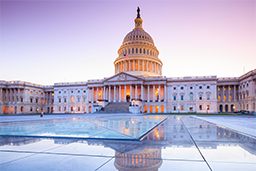The House passed sweeping legislation Saturday to respond to the coronavirus outbreak, an overwhelmingly bipartisan vote to expand access to free testing, provide $1 billion in food aid, and extend sick leave benefits to vulnerable Americans. Here, in question and answer form, Michelman & Robinson, LLP addresses some of the employment and tax implications of the bill that may be of particular interest to you.
Q. What is the purpose of the Families First Coronavirus Response Act (the "Act")?
A. This new emergency legislation provides "paid leave, establishes free testing, protects public health workers, and provides important benefits to children and families." It is expected that the Senate will vote on the legislation in the coming days, and President Trump has indicated that he supports the legislation. That being said, it is important to note that the current version of the Act analyzed in this alert may not be the final word and there may be additional changes and guidance to come.
Q. What group of workers does the Act affect?
A. The Act covers all workers, and there are particular provisions for health care workers.
Q. What provisions are made regarding paid leave?
A. Division D of the Act is the Emergency Paid Leave Act of 2020. This provision amends the FMLA and creates a new federal emergency paid leave benefits program. It defines an "emergency leave day" as a day in which an individual is unable to work due to one of the following reasons:
- The worker has a current diagnosis of COVID-19
- The worker is quarantined (including self-imposed quarantine) at the instruction of a health care provider, employer, or government official to prevent the spread of COVID-19
- The worker is caring for another person who has COVID-19 or who is under a quarantine related to COVID-19
- The worker is caring for a child or other individual who is unable to care for themselves due to a COVID-19-related closing of their school, child care facility, or other program.
Q. Who is eligible for emergency leave day protection?
A. The FMLA has been expanded to include employees who were "working in the 30 days before they were impacted by COVID-19." Employees are not required to meet the ordinary 1,250 hours of service requirement to be covered and take advantage of emergency paid leave under the FMLA.
Q. What is the leave the Act provides employees?
A. Eligible workers will receive a benefit for a month (up to three months) in which they must take 14 or more days of leave from work due to any of the above reasons. Note that if workers are paid sick leave, regular wages, etc., then those days are not "emergency leave days." Consistent with existing FMLA leave, this leave is also job-protected, meaning an employer must return the employee to the same or equivalent position upon his or her return to work.
Q. In addition to leave under the FMLA, must employers provide employees with paid sick leave?
A. Yes, the Act requires that employers provide full-time salaried employees paid sick time that is sufficient to provide the employee with 14 continuous days away from work without a reduction in pay, and for a part-time or hourly employee, paid sick time equal to the number of hours that the employee was scheduled to work or, if not so scheduled, regularly works in a 14-day period. The additional paid sick time shall be available for immediate use by the employee regardless of how long the employee has been employed by an employer. Notably, the additional sick time may be taken intermittently or on a reduced leave schedule, and an employer may not require an employee to take the additional sick time in a single period. After using this additional sick time, the employee may then use any other accrued sick time they previously had available.
Q. Can an employer seek government reimbursement for providing the additional paid sick leave?
A. Yes, but only if the employer meets the definition of a "qualified employer," which means an employer who employs 50 or fewer employees. A qualified employer of an employee who uses additional paid sick time under the Act during a public health emergency is eligible to be reimbursed by the Secretary of the Treasury for the wages paid to the employee for the period during which the employee used the additional paid sick time.
Q. May employees seek unemployment assistance under the Act?
A. Yes, the current bill provides for additional emergency funding for unemployment insurance benefits, including both processing and payment. Employees should be directed to the appropriate state unemployment insurance website.
Q. Are domestic partnerships covered under the Act?
A. Yes, employees may take leave to care for a domestic partner, which the Act defines as another individual with whom the individual is in a "committed relationship."
Q. How will the Act be enforced?
A. To ensure compliance with the Act, the Secretary of Labor will have the investigative authority provided under section 11(a) of the Fair Labor Standards Act with respect to employers, employees, and other individuals affected. Employees will also have a private right of action to seek monetary damages and/or equitable relief against any employer for a violation of the Act in the appropriate federal or state court. As for potential damages, an employer who violates the Act may be liable for monetary damages equal to lost wages and other compensation, interest, liquidated damages, and attorney’s fees. That being said, employers should be sure to make, keep, and preserve records pertaining to compliance with the Act.
Q. Are there any specific protections for health care workers?
A. Yes, the legislation creates new protections for health care workers. The Occupational Safety and Health Administration has been directed to issue an Emergency Temporary Standard to protect workers from COVID–19. Once issued, the Secretary of Labor is to promulgate a permanent standard that requires employers to develop and implement a comprehensive infectious disease exposure control plan that is, at a minimum, based on the precautions for severe acute respiratory syndrome (SARS) in the "2007 Guideline for Isolation Precautions: Preventing Transmission of Infectious Agents in Healthcare Settings" of the Centers for Disease Control and Prevention.
Q. What tax credits will be available to employers for employees’ paid sick and family leave?
A. The bill provides for a refundable U.S. federal income tax credit ("Tax Credit") equal to 100% of qualified paid sick leave wages (subject generally to a daily cap of $511 sick leave wages and an overall 10-day cap of sick leave wages per employee) or family leave wages (subject generally to a daily cap of $200 family leave wages and an overall $10,000 cap of family leave wages per employee) paid by an employer to its employees for each calendar quarter. The Tax Credit for sick leave wages applies to amounts paid to employees who must self-isolate, obtain a diagnosis, or comply with a self-isolation recommendation with respect to coronavirus. The Tax Credit for family leave wages applies to amounts paid to employees caring for a family member or for a child whose school or place of care has been closed due to coronavirus. The Tax Credit, whether for sick leave wages or for family leave wages, is allowed as a full dollar-for-dollar offset against the employer portion of U.S. Social Security taxes. Additional rules, limitations, and elections apply.
Q. What tax credits will be available to self-employed individuals for personal sick and family leave?
A. As with employees, self-employed individuals also qualify for Tax Credits if they (i) must self-isolate, obtain a diagnosis, or comply with a self-isolation recommendation with respect to coronavirus or (ii) are caring for a family member or for a child whose school or place of care has been closed due to coronavirus. The amount of the Tax Credit available to self-employed individuals is calculated in a slightly different manner than described above, and is allowed as a full dollar-for-dollar offset against U.S. federal income taxes. As with employees, special rules and limitations apply.
Q. What about applicable regulations and guidance?
A. The Act does not address the precise timing and mechanics for claiming the Tax Credit. The Secretary of the Treasury is authorized to provide that guidance, as well as set forth regulations related to avoidance, penalty waivers with respect to deposit amounts, compliance and record-keeping relief, and benefit recapture. To date, the Secretary has not issued any regulations or guidance with respect to the bill.
Q. What is the effective duration of the Tax Credit?
A. The Act would become effective shortly after it is enacted on the date specified by the Secretary of the Treasury (or delegate), and sunset on December 31, 2020.
Should you have any questions concerning the Families First Coronavirus Response Act, do not hesitate to contact M&R’s employment or tax professionals at your earliest convenience.
This blog post is not offered, and should not be relied on, as legal advice. You should consult an attorney for advice in specific situations.

